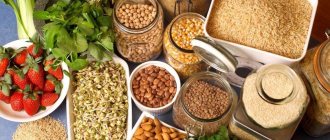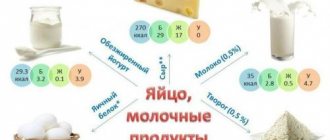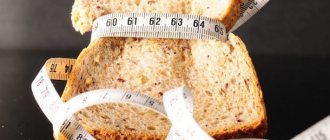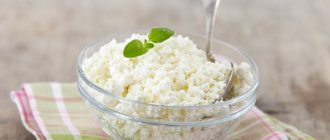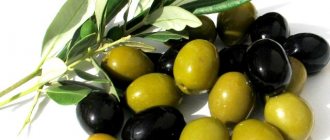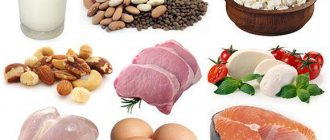Diet for gaining muscle mass
This diet is designed for a person weighing 100 kg.
To calculate the amount of protein per day for your weight, use the formula: 2 grams of protein multiplied by your weight. That is, if your weight is, for example, 80 kg, then you need to consume 160 grams of protein per day. As your muscle mass increases, increase the amount of protein and carbohydrates you take. BZHU ratio for weight gain:
- Proteins – 25%
- Fats – 10%
- Carbohydrates – 65%
Nutritional value of the diet (per day):
- Protein – 200 g
- Carbohydrates (mostly complex) - 500 g
- Fats - 80 g
- Calorie content - 3520 kcal
Products included in the diet:
- Chicken fillet - 260 g (55 g protein)
- Marbled meat (beef) - 340 g (55 g protein)
- Eggs - 6 pcs. (40 g protein)
- Brown rice - 230g (170g carbs, 19g protein)
- Buckwheat - 250 g (170 g carbohydrates, 31 g protein)
- Oatmeal - 100 g (62 g carbohydrates)
- Orange juice - 300 ml (36 g simple carbohydrates)
Additionally (to improve taste):
- Dried apricots
- Kishmish
- Garlic
Where can I get 200 gr. protein/day in diet?
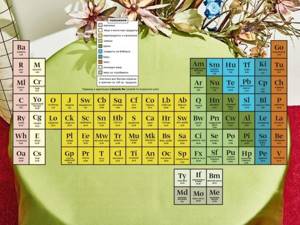
littlef0x: I don’t understand how you can eat 200 grams of protein per day? Is it necessary to eat all sorts of rubbish like low-fat cottage cheese with boiled breasts? But this is unbearable. clck.ru/BoKSx
Znatok Ne: Yes, in principle it’s not difficult, all protein, both animal and plant, is taken into account (the recommended ratio is usually 2/3 - animal protein, 1/3 plant).
PERIODIC TABLE OF PROTEINS from Wired! vk.com/wall3065546_672
Well, for example (I take into account my taste preferences, i.e. if you use your imagination, you can choose your own products):
- 3 eggs for breakfast - ~15g Squirrel - Poultry Carpaccio - 200 g ~35g Squirrel - House in the village Cottage cheese Low-fat 0.2% (I write low-fat because I like it that way, but you can take 5%), a couple of jars per day (200 g each) is ~40 g Protein - Post-workout protein shake ~50-60 g Protein - Lean beef steak for dinner, 150-200 grams - ~35-40 g Protein
PS: Well, or you can get proteins from fish, seafood, incl. canned (for example, in its own juice), chicken (not necessarily just chicken breast, you can use other parts of the body, with moderate fat content), turkey, pork tenderloin (it is quite lean), rabbit meat, a wide range of fermented milk products.
So it adds up to 200 grams of protein, and this doesn’t even take into account the vegetable protein.
If you haven’t settled into your eating habits yet, then you can partially get protein from sports nutrition: for example, add another portion of a protein shake before bed.
Oleg Zelensky: I’ll add my life hacks.
- In dishes with eggs I often do not use all the yolks. Previously, you had to throw them away, but now the protein is sold in bottles separately. And this is even here in Vladivostok. And some dishes, in general, can only be used with proteins. For example, I add chopped heat-treated protein to vegetable salads. Tasty and lots of protein.
- Low fat cheese. It can be melted (President Light, for example). Sometimes it's ordinary. In addition to fewer calories, there is an increased amount of protein. For example, we have low-fat cheese in our stores - 32 grams of protein per 9 grams of fat. And delicious, IMHO. It's very easy to get the norm with him.
- Various types of turkey and chicken. For example, this is a very tasty thing. 12 grams of protein per 3 grams of fat - https://www.v-dymov.ru/products/vysokaya-kuhnya/shato/ - chicken does not have to be boiled. You can do it on the grill, for example. Or fry, but with a small amount of oil. Or bake it. I don't like boiled breasts either. Some types of ready-made chicken basturma also have no more than 130 kcal with a high percentage of protein and are delicious.
- Tuna. More often I take it canned, occasionally fillet. Just not in oil. Huge amount of protein. There is also pollock caviar. 129 kcal, 28 grams of protein and great on sandwiches. Squid/Scallop is also high in protein and low in fat.
- Low-fat soft cottage cheese.
Something like this. https://www.utkonos.ru/item/14/1034600 The consistency is not at all dry, like regular cottage cheese. I sometimes add sweetener or fruit.
The most important life hack is to count the protein in all foods. For example, most flour products contain about 7 grams of protein. Milk contains about 3. If you take all this into account, then you can gain 200 grams (out of my 2500 daily calories) per day.
True, I won’t say that it’s easy. Or it’s nice to have such a diet every day. But taking into account the fact that this is necessary precisely during the diet period, it is quite possible.
This material was published on Dmitry Pikul’s blog, 09/12/2017.
Menu for the day
Meals should be distributed in such a way that the body receives the required amount of protein throughout the day, in this case - 60-70 g of protein at one time. A larger amount simply will not be absorbed. That is, if you need to consume 200 g of protein per day, this does not mean that you can eat it at one meal, for example, breakfast, and for dinner be left without feeding your muscles with protein. Portions should be distributed in approximately equal parts throughout the day.
Breakfast
- Oat flakes - 100 g (62 g carbohydrates)
- Scrambled eggs - 6 whites, 2 yolks (40 g white)
- Orange juice - 300 ml (36 g simple carbohydrates)
Dinner
- Marbled meat (beef) - 340 g (55 g protein)
- Brown rice - 230g (170g carbs, 19g protein)
Dinner
- Chicken fillet - 260 g (55 g protein)
- Buckwheat - 250 g (170 g carbohydrates, 31 g protein)
You can diversify your diet with other products to your taste. The basic rule is the nutritional value of the diet (per day): protein - 200 g, carbohydrates (mostly complex) - 500 g, fats - 80 g. For example, instead of chicken fillet or marbled meat, use turkey fillet, 260 grams of which also contains 55 g protein.
Use our calorie calculator to accurately calculate your caloric intake, visit the gym regularly and you will certainly start gaining muscle mass.
During the day, between main meals, eat vegetables and fruits, and also do not forget to drink clean water - at least 2.5 liters per day.
Real numbers
The calculator on my website defaults to 1.75 g of protein per kg of body weight per day - this is a sufficient amount of protein for most healthy people working out in the gym. That's about 130 grams of protein for the average person (75 kg) and yes, that's enough for you too.
In fact, the World Health Organization recommends an intake of 0.75 g/kg/day - that's about 60 grams (except for children, the elderly, pregnant and lactating women). Yes, yes, so “a little”, imagine. You can read more about this in the 10th edition of the American National Research Council Dietary Guidelines.
If anything, I quote verbatim: “...the recommended allowance for reference protein is 0.75 g/kg per day for both sexes.” You can search directly on this line.
Based on this, on the official website of the Australian Ministry of Health, for example, there is even a table with figures for the recommended amount of protein per day by gender and age groups. There, too, 0.6-0.9 g/kg/day.
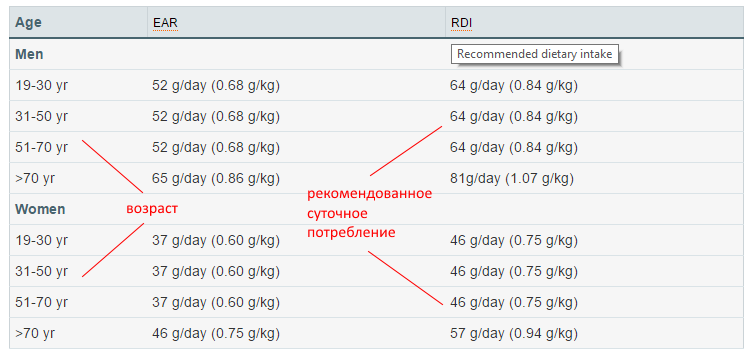
It's clear that if you regularly go to the gym and lift weights, you need more protein than the average person. But how much exactly?
There are a lot of scientific articles on this topic. For example, this one, in which scientists from Canada recommend consuming 1.3-1.8 protein per kg per day, as the optimal amount for most exercisers, and 1.8-2 g/kg/day for those who are “cutting”. About the same figure - 1.4-2 g of protein per kg per day - is recommended by the International Society of Sports Nutrition for all gym workers.
Thus, the default 1.75 g/kg of protein per day adopted on my site corresponds to basic modern ideas about nutrition. This amount is enough for your eyes. If you want more, choose 2.0 or 2.2 g/kg/day, there is such an option. But even in this situation, you are unlikely to count 200 grams of protein per day.
Cooking method
Cooking Chicken or Turkey Fillet

- Make shallow cuts to stuff the chicken or turkey fillet with garlic.
- Pepper and salt to taste and fry until done.
Preparation of marbled meat (beef)

- Make shallow cuts to stuff the meat with garlic and dried apricots.
- Place onion sliced into rings on foil, place meat on top, season with your favorite spices, salt and wrap.
- Bake at 175 degrees until done (about 45 minutes).
Bon appetit!
Fast metabolism
The required amount of calories, protein and other nutrients for people engaged in bodybuilding for the purpose of gaining muscle mass is a highly speculative topic.
However, this topic is especially significant for people for whom gaining muscle mass is a difficult task. After all, proper training will be effective only if it is supported by a balanced diet in sufficient volume for growth. Most hardgainers are such due to their fast metabolism. According to my observations, for a hardgainer, the effect of nutrition is the same regardless of how many grams of protein he consumes - 1.5 g per 1 kg of body weight or 2.5 g. In general, the formula in which the protein norm is determined by grams per kilogram of body weight is not indicative. I believe that it is more practical and effective to use the percentage of proteins, fats and carbohydrates. According to nutritional research, a lean man's diet should include:
20% proteins 20% fats 60% carbohydrates.
According to sports nutrition, a person who has an increased metabolism must provide calories, the amount of which is determined by the formula:
Q = mk,
Where
Q – daily calorie intake, m – current body weight, k – metabolic rate. The value of the coefficient depends on physical activity (the number of training sessions per week, the presence/absence of other physical activity during the day, body growth) and ranges from 40 to 50 (if training sessions are at least a week, there is no other physical activity, the metabolic rate does not go off scale and growth is low, then the coefficient value is close to 40, and vice versa). A calorie calculator was created based on this formula (see below).
The value obtained from this formula is the basic one. At its core, the basic value of calories obtained from food corresponds to the number of calories burned, taking into account physical activity. Thus, it is consistent with the concept of general metabolism .
The basic amount of calories should be taken as 100%. Of these one hundred percent calories:
- 20% must be obtained from proteins (of which 60% are of animal origin and 40% of plant origin),
- 20% - from fats (of which at least 80% are unsaturated fats),
- 60% is from carbohydrates (of which at least 80% are slow carbohydrates).
Protein content of major protein-containing foods
This is the approximate protein content of the listed products in round numbers. Of course, not accurate to the last decimal place, but that doesn’t matter. In practice, such precision is not needed.
- Beef (1kg) – 200 g
- Pork (1kg) – 200 g
- Lamb (1kg) – 200 g
- Veal (1kg) – 200 g
- By-products (1kg) – 155 g
- Poultry (1kg) – 220 g
- Fish (1kg) – 175 g
- Seafood (1kg) – 155 g
- Cheese (1kg) – 220 g
- Egg (1 piece) – 7 g
- Milk (1l) – 30 g
Making up a diet
So, we found out that a beginner athlete weighing 75 kg is recommended to consume 150 grams of protein per day. Let's try to achieve this figure using regular products from the nearest supermarket.
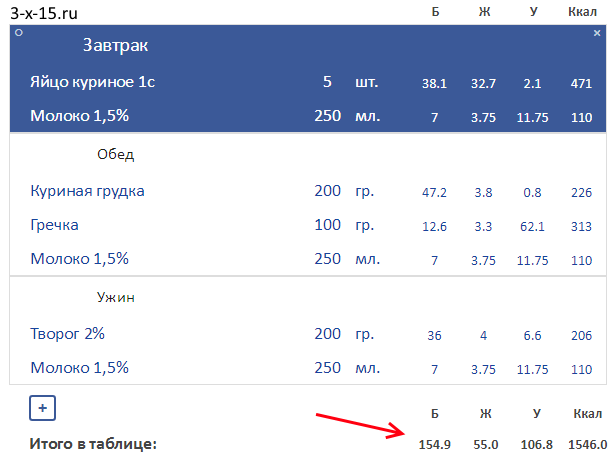
As you can see, such a simple diet easily scores the required protein points for a person weighing 80 kg. And this is not some mountains of food, but a nutrition plan that is quite moderate in volume. It even contains just over 1,500 calories, which, of course, will be extremely insufficient for an 80-kilogram fitness enthusiast. Naturally, a person will add something else to this diet, one way or another this will increase the protein content.
It turns out that, contrary to popular belief, the daily requirement for protein can be easily met with regular foods, without resorting to sports nutrition at all. I'm not saying that protein powder is harmful. No, of course, it is completely safe (when used according to the instructions). I argue that for the vast majority of people, sports nutrition is simply excessive.
You don’t need to think that results in the gym are achievable only with the help of sports nutrition, these are harmful thoughts, they interfere with you. Provided that you eat a varied, nutritious diet and do not use steroids, the presence or absence of sports nutrition does not affect anything. Go to the gym regularly, eat well, sleep a lot, and you will succeed.
If you liked the material, share it, so you will help the site develop. Or just like it, I will be pleased. You can find out about the release of new articles by subscribing to the VKontakte group. Good luck!
LiveInternetLiveInternet
Nutrition, Healthy recipes
Hi all! Denis Semenikhin is with you, and today we will not talk about training, we have already talked about them enough in other sections. And I’m sure that you all train regularly, you ask a lot of questions about this, and from time to time your questions include requests to talk about the topic of homemade sports nutrition. Because we all understand that being in good physical shape without following the basics of proper nutrition is naturally not possible.
Homemade sports nutrition
At one time, if you remember, I made an issue dedicated to the basics of proper nutrition, the basic proportions that need to be observed in nutrition, and the norms for the consumption of foods or certain elements, which raised a huge number of your questions. And all this made me understand that it’s time to make a whole series of issues devoted not only to the theory of sports nutrition and what kind of sports nutrition exists, but also to the practical side of this issue!
So that you understand not only how much you need to eat, but also how this can be achieved from living real products. For example, regarding the amount of protein per day. I weigh 105 kilograms , that is, I need 210 grams of protein .
If you weigh, for example, 70 kg , then how can you gain 140 grams of protein per day?
So, today, guys, I’ll show you what these 140 grams of protein , and high-quality protein.
I am a complete amateur in cooking, but, nevertheless, in order to have a low percentage of subcutaneous fat and large muscles, you need to follow certain rules. Today I will tell you how to implement them.
So, we will now prepare 140 grams of protein.
What do I have for this:
- 2 chicken breasts
- 1 piece of steak
- 5 raw chicken eggs
Quality protein
I want to immediately apologize for the fact that I will suddenly do something wrong, perform technically incorrect actions, but this is how I do it.
We place our chicken breasts and steak on a frying surface, this can be a non-stick frying pan, we do not use oil. Or you can use a special device for frying food. The highest quality protein, from the point of view of the amino acid set and the readiness of our body to accept it, is egg white . The second most rated protein is milk protein , then almost at the same level in terms of digestibility are chicken, poultry, meat, and fish.
What about components? What will we get from our three “items” that we are now frying?
- 2 chicken breasts provide approximately 30 grams of protein each.
- 1 piece of steak (approximately 240 grams) will give us approximately 50 grams of protein.
And now I propose to prepare egg whites - 5 pieces. I will still allow myself to leave and cook one egg yolk, just for the taste, let it be. Do not need anymore! I throw the rest of the yolks away. You can place a few chopped tomatoes nearby on the frying surface, also for taste.
Product consumption standards
So, we have prepared: 2 chicken breasts, 1 steak, 5 egg whites with one yolk.
5 egg whites are approximately 30 grams of protein plus about 5 grams of fat. In a steak we have 50 grams of protein and approximately 30 grams of fat (depending on the fat content of the meat). There is generally little fat in chicken breasts; I cooked everything without oil.
Accordingly, in total, you guys and I received 140 grams of high-quality protein and at the same time some 35 grams of fat. That is, this is exactly what you need! All you have to do is add the right amount of carbohydrates and that’s it, ideal nutrition is guaranteed!
This is exactly what a person who weighs 70 kg needs, who leads an active lifestyle, works out and strives to build muscle mass. Everything we have prepared now will be needed within 24 hours! If you think it’s impossible to eat this in one day, then I just don’t know what to say. While I was preparing all this, I inhaled these smells so much that I could simply swallow all these products in one go.

